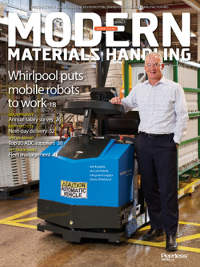9th Annual Salary Survey: Success and Satisfaction Continue to Reign
Materials handling professionals embrace the challenges of technological progress, daily troubleshooting and the ongoing overhaul of the entire supply chain; and they are well compensated for their efforts.
The results of Modern’s 9th-annual Salary Survey show that materials handling professionals are still well-compensated, still challenged daily to help their company keep pace with the industry’s rapid change, and, yes, still aging. This year’s survey base included a significantly larger number of more seasoned materials handling professionals. A record 24% have spent 30 or more years in the industry, up from a previous high of 18%. Although the number of respondents over 65 held at 7%, the 55- to 64-year-old cohort grew 5% in the latest survey. The percentage of 18- to 34-year-olds remained at 9%.
Download the complete 2016 Salary Survey here.
Those who do find their way into materials handling can expect to be paid well for their work. After peaking last year at an eight-year record of $98,000, average base salaries fell to $91,625—a 6.5% decrease. However, it seems as though companies are increasingly rewarding performance with larger and more widely available bonuses.
Of the 72% of respondents who received a bonus last year, 10%—double that of previous years—received bonuses between $30,000 and $50,000. Respondents reported an uptick in the number of bonuses between $3,000 and $10,000, while the percentage of those who earned additional rewards of less than $1,000 tripled. Although more employees are seeing bonuses, only 4% earned more than $50,000, less than half the percentage reported in previous years.
Two thirds of bonuses are granted based on the company’s performance goals, a percentage that has remained unchanged in recent years. However, just 43% were rewarded in 2016 for their individual performance, the lowest in recent years. It’s a small decrease, but it’s offset by increases in respondents whose companies achieved increased sales (32%), lower operational costs (24%) and better inventory management (13%).
The 27% of respondents with bonus or commission plans said they increased by an average of 24%. This marks five consecutive years of increases greater than 20%, and the average bonus now sits at $27,805 (median $10,000), easily surpassing last year’s record. As a result, the survey reported overall compensation down just 2%.
Whistle while you work
The survey’s respondents certainly aren’t complaining, as satisfaction is still nearly perfect, including 71% who are very or extremely satisfied with their jobs. In the open comments section of the survey, respondents noted the challenging, fast-paced and ever-changing nature of their work, yet nearly one in five report their jobs are less stressful than they were two years ago. Similarly, 95% would recommend the materials handling profession to others.
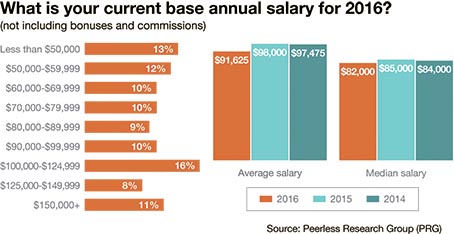
The frequency of dramatic cost-saving measures like layoffs (26%) and pay cuts (22%) rose a few percent in the last year after three consecutive years of decreases. A slightly larger number of respondents also reported reductions in benefits and healthcare (26%). Hiring plans continued a slow downward trend after several years of growth, as 60% reported their companies added personnel in the last 12 months.
Last year, 72% of respondents said their salary had increased in the previous 12 months, but this year that figure is at 65%. Just 3% reported their salaries had decreased, and a third of respondents’ salaries stayed the same. In 2015, the average base salary increase was 4.9%, dropping below the 5.2% averages of previous years. They have since returned to 5.4% (median 3%). Of those respondents whose salaries increased last year, one in five received increases of 5% to 9%, and 14% saw raises of 10% or more. 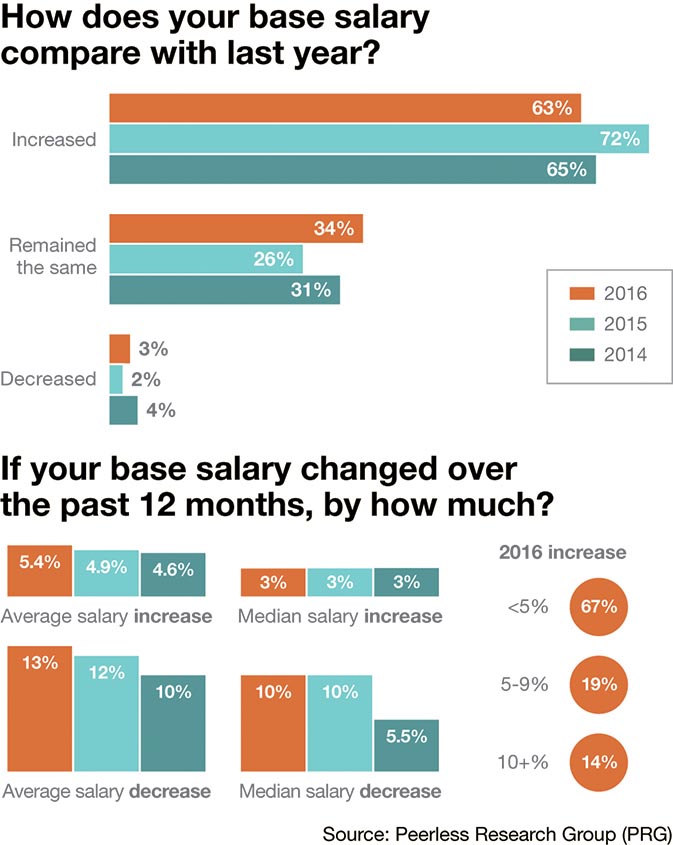
In the months and years to come, 49% expect to finish their careers with their current employer, up from 46% last year. Just more than a third are unsure, and only 15% are sure they will end up somewhere else, down 7% from last year. About 46% have already been with their employers for at least 10 years—including 22% with more than 20 years of tenure.
Job satisfaction
Nearly one in five professionals expressed “extreme satisfaction” with their careers, returning to past levels after bottoming out at 16% in recent years. The percentage of those “very” or “somewhat” shifted slightly to 52% and 26%, respectively. Today, just 2% are “not very” satisfied, and 1% are not at all satisfied.
This year, a third of respondents indicate no interest in seeking another job, just above last year’s record lowest. About 36% say they are “always open to other possibilities.” Roughly a quarter are passively looking for work elsewhere and the same 8% are actively looking. Those looking elsewhere are motivated primarily by compensation (58%), the desire for new challenges (34%), and a lack of advancement opportunities (31%). However, all of these percentages are down, and the only priority that has increased is the desire for different management (23%). 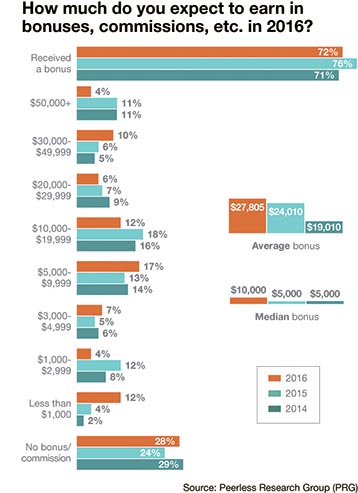
In the post-recession recovery, our survey’s questions surrounding workplace stress showed a visible sigh of relief. This year there was another hint of relaxation as a five-year high of 18% said their jobs are less stressful than they were two years ago. The same 45% say stress has increased—a figure that has not dipped below 43% in the history of the survey—and 37% say stress levels have remained the same. Among the 10% who report their job is “extremely” stressful and the 32% whose work is “very” stressful, the top complaints included workload (51%), lack of staffing (47%), lack of enough time to get the work done (40%), balancing work life and home life (39%), questionable management decisions (39%), and working with outdated technologies (32%).
Demographics
This year’s survey reflects the perspectives of much smaller companies than last year, with 16% (double 2015’s figure) working for companies with estimated 2016 revenues under $10 million. Another 21% expect between $10 million and $50 million. Last year, nearly half of respondents’ companies were larger than $250 million, including 24% above $2.5 billion. This year, 42% crossed the quarter-billion mark, and just 19% expect to surpass $2.5 billion.
Respondents represent industries including industrial machinery (9%), transportation and warehousing services (7%), wholesale trade (7%), 3PLs (6%), food, beverage and tobacco (6%), and automotive and transportation equipment (6%). Primary job functions of respondents include warehouse, distribution and logistics (38%), engineering (16%), plant management (13%), company management (11%) and purchasing (8%). 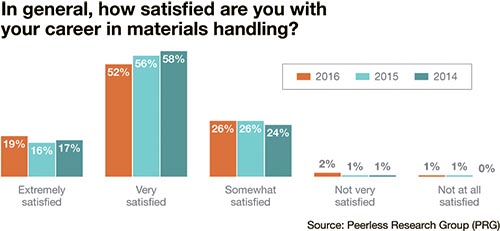
Fewer than 23% of respondents have been in the materials handling profession for less than 10 years, and 50% have been at it for more than 20 years. Last year, the survey indicated 13% of respondents with 30-plus years in the field, a number that has nearly doubled to 24%.
On average, those who have been in the industry less than five years can expect to earn $72,725. But if they stick with it, their next decade could produce a 23% to 31% increase, to an average of between $90,000 and $95,000 for those with 10 to 15 years or 15 to 20 years in the profession, respectively. Above the 20-year mark, the average salary hovers around $107,000.
The 11% of respondents in company management (CEO, VP, GM, etc.) added about $10,000 per year between 2013 and 2015, when salaries averaged $163,000. The 2016 survey reports an average of $143,000 for this cohort. Conversely, the engineers who make up 16% of the survey base saw average salaries increase from $88,800 to a little better than $93,000. Following a spike last year to $94,000, salaries for the warehouse, distribution and logistics supervisors who make up 38% of respondents fell to levels seen in previous years at $85,900. 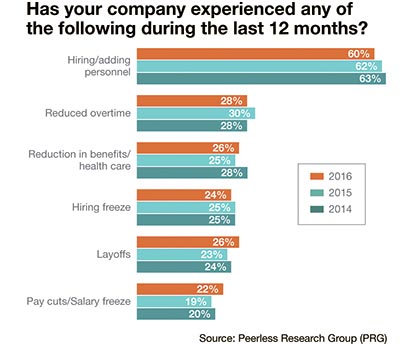
Those with supervisory responsibilities (73%) can expect to earn 25% more than their non-supervisor colleagues, a gap that has closed somewhat in recent years. Those with budgetary responsibilities (64%) will earn about 30% more than those without, a gap that has also fallen from nearly 40% two years ago.
Average combined salaries and benefits have stabilized in certain regions of the United States. In the Midwest, where 40% of respondents are located, salaries nearly broke six figures in recent years, only to settle to 2013 levels at about $90,000. In the mid-Atlantic region, home to 17% of respondents, the average salary crossed the $100,000 mark last year, but now stands at $94,900, the lowest since 2012.
In the Southeast, where 13% of all respondents are employed, average salaries fell only slightly to $95,900. In the West, where 12% of respondents reside, average salaries held at $95,000, after falling last year from the longstanding average of $100,000. Following several consecutive years of growth totaling 16% since 2012, salaries of the one in 10 respondents from the South held flat at $97,450.
Respondents, by the numbers
In September of 2016, Modern Materials Handling subscribers received an invitation by e-mail to participate in the 9th-annual salary survey. The e-mail included a dedicated URL linked to a Website that hosted the questionnaire. The study, performed by Peerless Research Group, received a total of 603 responses from qualified materials handling professionals.
The average respondent earns $91,625 in salary, which is down 6.5% from last year and the lowest since 2012. The median salary fell slightly to $82,000. Bonuses, on the other hand, have increased for the fifth year in a row to an average $27,805 from around $24,000 last year. The median bonus doubled to $10,000 after holding at $5,000 since 2012.
The average respondent is a 54-year-old, continuing an upward trend from the previous 51-year-old average. He has worked with his company for the past 10 years of his 19-year materials handling career, during which time he has worked for 2.4 companies.
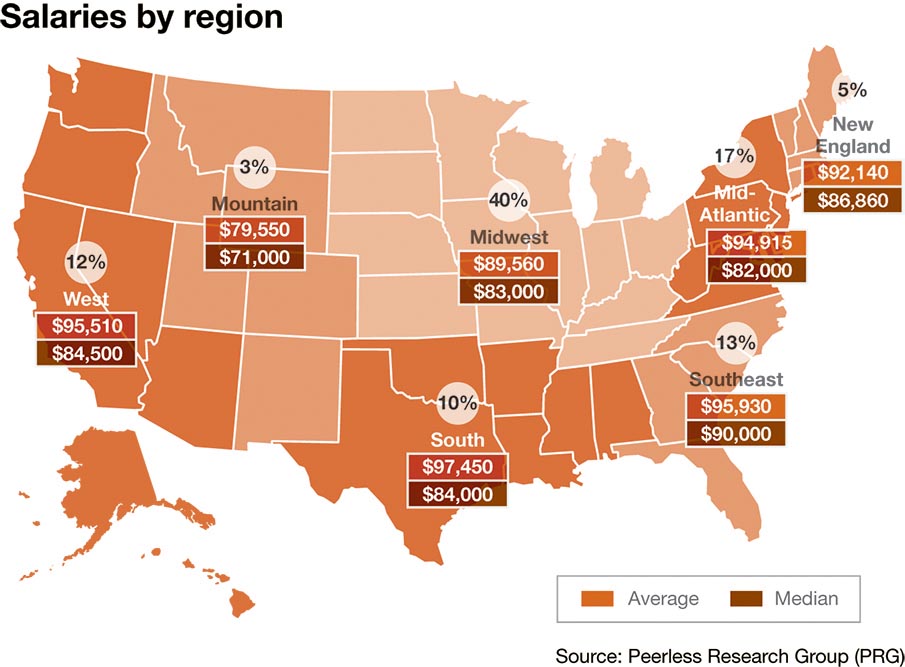
Females continue to hold 11% of materials handling positions, and average salaries for women fell to 2014 levels at $74,000, down from $90,000 last year. The median female salary fell to its lowest in years at $57,000. The average male salary also declined from $98,700 to $94,200, while the median held at $85,000.
The average respondent has a budget authority of $223,550 (median: $28,200). About 80% of respondents work for manufacturing companies. The average respondent works for a company with 3,163 employees (median: 496) and an estimated annual revenue of $692 million (median: $141 million).
Among respondents, 46% have been in the materials handling industry at least 10 years, and 22% have been at it for more than 20 years. The same 11% have been in the industry less than five years.
Only 7% of respondents were personally impacted by layoffs in the previous 12 months, which matches the record low of the last six years.
They don’t just do it for the money
Open-ended responses from the 95% of survey participants who would recommend the materials handling profession to others.
- It is a great career choice if you are willing to learn and adapt to your environment.
- It’s an opportunity to help customers using engineering and analytical skills. Varied applications keep things interesting.
- This is a necessary and important part of the materials distribution process. This process is vital to the stability and viability of our families and country.
- It is a growing field that is underrated by those who do not understand warehousing. It is an integral part of the whole supply chain.
- It is truly one of the most advanced fields in our overall industry. Most college-age people are shocked by the level of sophistication we have.
- It’s not where I saw myself coming out of school, but it’s a rewarding, results-driven profession where I’m constantly challenged and always learning.
- The pay and benefits are outstanding.
- There are exciting opportunities and challenges, growing demand for people, and exposure to new cutting-edge technologies.
- It is not one of those careers that turns stale, boring or mundane. There are so many conditions that change on a daily basis.
- I would recommend this type of work because I love knowing that I’m helping masses of people with what I do.
- Product is always going to be produced, and everything needs labeling, coding or marking. But the industry needs new blood, new vision.

Article Topics
Inventory & Picking News & Resources
Siemens, Universal Robots, and Zivid partner to unveil smart robotic picking solution AI-based inventory monitoring solution provider Gather AI raises $17 million NRF 2024 retail sales forecast calls for growth Swisslog gives live demonstration of ItemPiQ latest evolution Cimcorp automates fresh food distribution with flexible storage, order picking solutions ABCO Systems acquires FastFetch The Ultimate Guide to Reducing Warehouse Travel More Inventory & PickingLatest in Materials Handling
Registration open for Pack Expo International 2024 Walmart chooses Swisslog AS/RS and software for third milk processing facility NetLogistik partners with Vuzix subsidiary Moviynt to offer mobility solutions for warehouses Materials Handling Robotics: The new world of heterogeneous robotic integration BSLBATT is looking for new distributors and resellers worldwide Lucas Watson appointed CSO for Körber’s Parcel Logistics business in North America Hyster recognizes Dealers of Distinction for 2023 More Materials HandlingAbout the Author
Subscribe to Materials Handling Magazine

Find out what the world's most innovative companies are doing to improve productivity in their plants and distribution centers.
Start your FREE subscription today.
April 2024 Modern Materials Handling

Latest Resources


